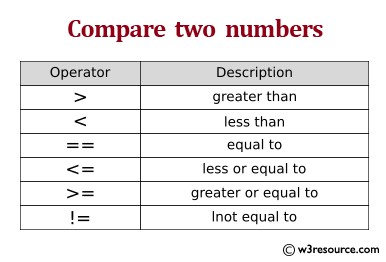Comparing numbers is a fundamental operation in any programming language, and Java provides several ways to perform this task. This article will guide you through different methods to compare two numbers in Java, using relational and equality operators, and discuss best practices for efficient and readable code.
Using Relational Operators
Java offers six relational operators for comparing numbers:
==(equal to)!=(not equal to)>(greater than)<(less than)>=(greater than or equal to)<=(less than or equal to)
These operators compare two numeric values and return a boolean result (true or false).
import java.util.Scanner;
public class CompareNumbers {
public static void main(String[] args) {
Scanner input = new Scanner(System.in);
System.out.print("Input first integer: ");
int number1 = input.nextInt();
System.out.print("Input second integer: ");
int number2 = input.nextInt();
if (number1 == number2) {
System.out.printf("%d == %dn", number1, number2);
}
if (number1 != number2) {
System.out.printf("%d != %dn", number1, number2);
}
if (number1 < number2) {
System.out.printf("%d < %dn", number1, number2);
}
if (number1 > number2) {
System.out.printf("%d > %dn", number1, number2);
}
if (number1 <= number2) {
System.out.printf("%d <= %dn", number1, number2);
}
if (number1 >= number2) {
System.out.printf("%d >= %dn", number1, number2);
}
}
}This code snippet takes two integer inputs from the user and then uses a series of if statements to demonstrate each relational operator.
Comparing Floating-Point Numbers
When comparing floating-point numbers (e.g., float or double), directly using == or != can be unreliable due to potential precision issues. A common practice is to compare them within a defined tolerance:
double number1 = 1.0;
double number2 = 1.000001;
double tolerance = 0.00001;
if (Math.abs(number1 - number2) < tolerance) {
System.out.println("Numbers are considered equal within tolerance.");
}Best Practices
- Clarity: Use meaningful variable names to improve code readability.
- Efficiency: When comparing multiple conditions, consider using
else ifstatements to avoid unnecessary comparisons. - Floating-Point Comparisons: Always use a tolerance when comparing floating-point numbers for accuracy.
Conclusion
Java provides straightforward methods for comparing numbers using relational and equality operators. Understanding these operators and following best practices, particularly when dealing with floating-point numbers, ensures accurate and reliable comparisons in your Java programs. Remember to prioritize code clarity and efficiency for maintainability and performance. For more complex comparison scenarios, consider exploring Java’s compareTo method, particularly when working with objects.
